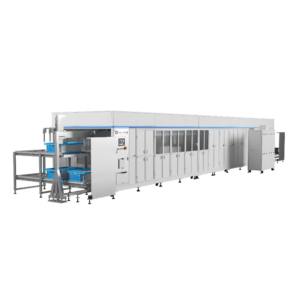Battery quality testing is key in assessing the cell’s operational performance and quality. OCV (Open Circuit Voltage) testing measures the battery voltage when it’s not connected to any load, and no current is flowing outside the cell. This non-intrusive test provides valuable insights into the battery’s state of charge and health.
During battery inspection, people would be perplexed by some concepts and would face some issues. To complete handle that smoothly, you need to know the answers to these common questions about OCV testing.
(Copyright Photo from: https://www.freepik.com/free-photo/high-view-battery-pollution-waste_11276189.htm#fromView=image_search_similar&page=2&position=26&uuid=9755bac4-4154-43d0-917b-336a7ba3d7aa)
Q1: What is the Open Circuit?
An open circuit refers to discontinuity in an electrical circuit because no current flows through it. It reflects the true potential difference between the terminals without being influenced by external factors.
Q2: What is OCV Testing for Lithium-Ion Battery?
For lithium-ion batteries, OCV testing involves determining the cell’s voltage in the resting stage when disconnected from the charge. This apparently simple test depicts the battery’s health, functionality, state of charge, and potential anomalies.
These batteries exhibit self-discharge capabilities, which causes the OCV values to drop with time. When the lithium-ion battery has an internal fault, the self-discharge process increases. It causes open circuit voltage to decline beyond the defined limit. A cell with an OCV that is too low or too high indicates a cell quality concern.
OCV testing also serves as an initial litmus test to detect defects, imbalances, or inconsistencies early on. It helps manufacturers rectify these issues and ensure that only batteries meeting the highest quality standards proceed.
Q3: What are the Differences Between Nominal Battery Voltage and OCV?
Here are some basic differences between nominal and OCV voltage types:
- Nominal Battery Voltage
Nominal battery voltage is the standardized or average voltage of a battery under normal operating conditions. For example, the nominal voltage of lithium-ion batteries is typically around 3.7 volts per cell. This value represents the average voltage that the battery can sustain during the discharging cycle. Plus, it is measured when the battery is in use, under load, and delivering current to a circuit.
These voltages provide a general idea of the voltage level a device can expect under typical usage.
- OCV
In contrast, OCV is measured in a no-load condition that provides a snapshot of the battery’s state of charge and overall health. It is determined when the battery is at rest, and reading is not influenced by any current flow.
OCV readings are crucial for quality control during manufacturing and for assessing the battery’s aging.
Q4: What is the Standard OCV?
The term Standard Open Circuit Voltage refers to a typical voltage range that is expected from a fully charged battery when no load is applied. For different types of batteries, the standard OCV varies based on their chemistry and design. Here are some standard OCV values for common battery types:
- For the Nickel-Cadmium cell, the normal open circuit voltage is approximately 1.2 V to 1.25 V[1]
- For lithium-ion cells the standard OCV for a fully charged lithium-ion cell could be around 4.2 volts[2]. As the battery discharges, the OCV gradually decreases to 3.0 volts[2].
Q5: How to Calculate the OCV?
The OCV of the battery can be calculated by employing a digital, analog voltmeter or OCV machine (for battery manufacturers), which can measure the cell’s voltage range. For that, during OCV testing, you should keep the battery at rest and join the positive and negative leads of the voltmeter to their respective battery terminals. As a result, a voltage is displayed on the voltmeter. This value is the battery’s OCV open circuit voltage.
For electrochemical cells, the OCV can be calculated using the Nernst Equation[3] if the concentrations of reactants and products are known.
The Nernst equation is:
E= E∘ – RT/nF* lnQ
Where:
E = OCV
E∘ = Standard Electrode Potential
R = Universal gas constant (8.314 J/mol·K)
T = Temperature in Kelvin
n = Number of moles of electrons exchanged
F = Faraday’s constant (96485 C/mol)
Q = Reaction quotient (ratio of concentrations of products to reactants)
Q6: Why is OCV Testing Important?
Battery performance and functionality are hitched to OCV testing. By leveraging the OCV values during the manufacturing phase, manufacturers can ensure that each battery’s performance aligns with stringent benchmarks.
By tracking OCV trends, the manufacturers anticipate battery behavior over time. For example, it provides predictive insights, such as when a battery may need maintenance or replacement, thereby preventing unexpected failures.
SZJ Automation OCV Machine
So, if you are ready to invest in a reliable OCV measuring device, look no other than SZJ. We are a leader in providing high-quality battery manufacturing equipment and testing machines. Our state-of-the-art OCV machine is designed to meet the highest standards of accuracy and operational efficiency in OCV testing. This advanced equipment leverages cutting-edge electronic measurement technology and high-precision sensors, enabling rapid and precise determination of a battery’s OCV.
Here are more features of the SZJ Automation OCV machine:
Annual Throughput: 800MW/year, ensuring high productivity and meeting large-scale testing demands.
Machine Operating Rate: Achieves an impressive operational efficiency with a rate of ≥98%, minimizing downtime and maximizing output.
Maximum Module Weight: Capable of handling modules weighing up to 45kg/pcs, providing versatility for different battery sizes and types.
Module Breakage Rate: Exhibits exceptional reliability with a module breakage rate of less than 1/10000, ensuring the integrity of tested modules.
Conclusion
In short, open circuit voltage testing is essential for ensuring quality and reliability during the battery manufacturing process. In this aspect, we, SZJ Automation, can offer intelligent turnkey battery production lines and battery manufacturing machines. With 20+ years of experience, over 87 invention patents, and 93 software copyrights, we are capable of bringing accurate OCV testing results and reliable battery production. If you are interested, please visit our SZJ Automation’s official websites to get more information or contact us directly.
Reference
- Available at: https://brainly.com/question/46997070
- Available at: https://iopscience.iop.org/article/10.1088/1742-6596/1325/1/012173/pdf#:~:text=The%20lower%20cut%2Doff%20voltage,the%20charging%20current%20is%20stable.
- Available at: https://computherm.com/calculate-open-circle-voltage-ocv-under-equilibrium-condition






